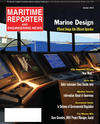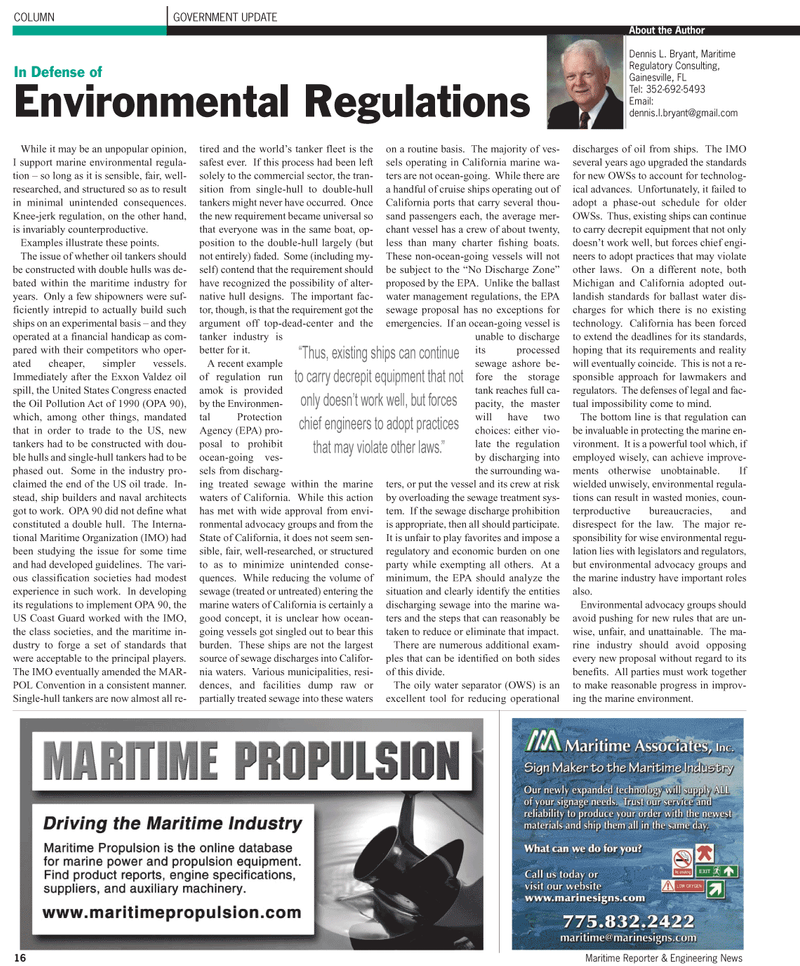
Page 16: of Maritime Reporter Magazine (February 2, 2010)
Read this page in Pdf, Flash or Html5 edition of February 2, 2010 Maritime Reporter Magazine
COLUMN GOVERNMENT UPDATE
In Defense of
Environmental Regulations
About the Author
Dennis L. Bryant, Maritime
Regulatory Consulting,
Gainesville, FL
Tel: 352-692-5493
Email: [email protected]
While it may be an unpopular opinion,
I support marine environmental regula- tion – so long as it is sensible, fair, well- researched, and structured so as to result in minimal unintended consequences.
Knee-jerk regulation, on the other hand, is invariably counterproductive.
Examples illustrate these points.
The issue of whether oil tankers should be constructed with double hulls was de- bated within the maritime industry for years. Only a few shipowners were suf- ficiently intrepid to actually build such ships on an experimental basis – and they operated at a financial handicap as com- pared with their competitors who oper- ated cheaper, simpler vessels.
Immediately after the Exxon Valdez oil spill, the United States Congress enacted the Oil Pollution Act of 1990 (OPA 90), which, among other things, mandated that in order to trade to the US, new tankers had to be constructed with dou- ble hulls and single-hull tankers had to be phased out. Some in the industry pro- claimed the end of the US oil trade. In- stead, ship builders and naval architects got to work. OPA 90 did not define what constituted a double hull. The Interna- tional Maritime Organization (IMO) had been studying the issue for some time and had developed guidelines. The vari- ous classification societies had modest experience in such work. In developing its regulations to implement OPA 90, the
US Coast Guard worked with the IMO, the class societies, and the maritime in- dustry to forge a set of standards that were acceptable to the principal players.
The IMO eventually amended the MAR-
POL Convention in a consistent manner.
Single-hull tankers are now almost all re- tired and the world’s tanker fleet is the safest ever. If this process had been left solely to the commercial sector, the tran- sition from single-hull to double-hull tankers might never have occurred. Once the new requirement became universal so that everyone was in the same boat, op- position to the double-hull largely (but not entirely) faded. Some (including my- self) contend that the requirement should have recognized the possibility of alter- native hull designs. The important fac- tor, though, is that the requirement got the argument off top-dead-center and the tanker industry is better for it.
A recent example of regulation run amok is provided by the Environmen- tal Protection
Agency (EPA) pro- posal to prohibit ocean-going ves- sels from discharg- ing treated sewage within the marine waters of California. While this action has met with wide approval from envi- ronmental advocacy groups and from the
State of California, it does not seem sen- sible, fair, well-researched, or structured to as to minimize unintended conse- quences. While reducing the volume of sewage (treated or untreated) entering the marine waters of California is certainly a good concept, it is unclear how ocean- going vessels got singled out to bear this burden. These ships are not the largest source of sewage discharges into Califor- nia waters. Various municipalities, resi- dences, and facilities dump raw or partially treated sewage into these waters on a routine basis. The majority of ves- sels operating in California marine wa- ters are not ocean-going. While there are a handful of cruise ships operating out of
California ports that carry several thou- sand passengers each, the average mer- chant vessel has a crew of about twenty, less than many charter fishing boats.
These non-ocean-going vessels will not be subject to the “No Discharge Zone” proposed by the EPA. Unlike the ballast water management regulations, the EPA sewage proposal has no exceptions for emergencies. If an ocean-going vessel is unable to discharge its processed sewage ashore be- fore the storage tank reaches full ca- pacity, the master will have two choices: either vio- late the regulation by discharging into the surrounding wa- ters, or put the vessel and its crew at risk by overloading the sewage treatment sys- tem. If the sewage discharge prohibition is appropriate, then all should participate.
It is unfair to play favorites and impose a regulatory and economic burden on one party while exempting all others. At a minimum, the EPA should analyze the situation and clearly identify the entities discharging sewage into the marine wa- ters and the steps that can reasonably be taken to reduce or eliminate that impact.
There are numerous additional exam- ples that can be identified on both sides of this divide.
The oily water separator (OWS) is an excellent tool for reducing operational discharges of oil from ships. The IMO several years ago upgraded the standards for new OWSs to account for technolog- ical advances. Unfortunately, it failed to adopt a phase-out schedule for older
OWSs. Thus, existing ships can continue to carry decrepit equipment that not only doesn’t work well, but forces chief engi- neers to adopt practices that may violate other laws. On a different note, both
Michigan and California adopted out- landish standards for ballast water dis- charges for which there is no existing technology. California has been forced to extend the deadlines for its standards, hoping that its requirements and reality will eventually coincide. This is not a re- sponsible approach for lawmakers and regulators. The defenses of legal and fac- tual impossibility come to mind.
The bottom line is that regulation can be invaluable in protecting the marine en- vironment. It is a powerful tool which, if employed wisely, can achieve improve- ments otherwise unobtainable. If wielded unwisely, environmental regula- tions can result in wasted monies, coun- terproductive bureaucracies, and disrespect for the law. The major re- sponsibility for wise environmental regu- lation lies with legislators and regulators, but environmental advocacy groups and the marine industry have important roles also.
Environmental advocacy groups should avoid pushing for new rules that are un- wise, unfair, and unattainable. The ma- rine industry should avoid opposing every new proposal without regard to its benefits. All parties must work together to make reasonable progress in improv- ing the marine environment. “Thus, existing ships can continue to carry decrepit equipment that not only doesn’t work well, but forces chief engineers to adopt practices that may violate other laws.” 16 Maritime Reporter & Engineering News

 15
15

 17
17
